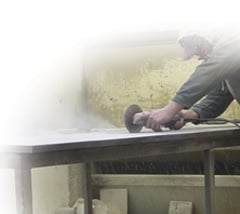Stone industry fails to reduce dust exposure
The stone industry is killing its workforce with silica dust and has made hardly any progress to stop doing so since visits by the Health & Safety Executive between 1992 and 1995.
That is the stark finding in the long-awaited and hefty Silica Baseline Survey (SBS) that has now been published by the Health & Safety Executive.
The survey finds there is little understanding in the industry of the levels of silica in stone and the dangers of Respirable Crystalline Silica (RCS).
The SBS covers brickworks & tile manufacture, quarrying, and construction, as well as stonemasonry. The stonemasonry annex (Annex 3) runs to 98 pages.
The main report says: “Many employers in the brickmaking and quarry sectors have invested significantly in exposure control measures. Some items of construction plant and machinery have also been modified to minimise exposure, but very little progress is evident in the stonemasonry sector.”
They say that actual exposure to dangerous levels of RCS might be even higher than earlier HSE estimates had suggested and that stonemasons could be the highest at-risk group.
One of the problems of silicosis that can develop from RCS and debilitate and kill, is that it can take a long time to develop and people tend to discount the future. Smokers ignore their own coughs and always seem to have known someone who smoked until they were 90.
In 2003 HSE research predicted that the reduction of the RCS exposure limit to 0.1mg/m3, which took place three years later, could prevent 185 premature deaths.
HSE guidance to the stone industry published in 2001 showed powered disc cutting and polishing could produce RCS exposure levels of up to 100mg/m3. Tools that use water dust suppression are not always much better because the dust can still hang in the air in water droplets, while pneumatic chiselling, often assumed to be safe, can produce up to 10mg/m3 and even hand chiselling can produce 2mg/m3.
The SBS says: “This failure by the stonemasonry industry to make significant improvements in control of exposure to RCS since 1995… indicates that comprehensive enforcement of the 2006 Workplace Exposure Limit would be likely to have a major impact on the industry.”
In other words, a few prosecutions might focus the industry’s collective mind.
The report can be downloaded from the website below.

